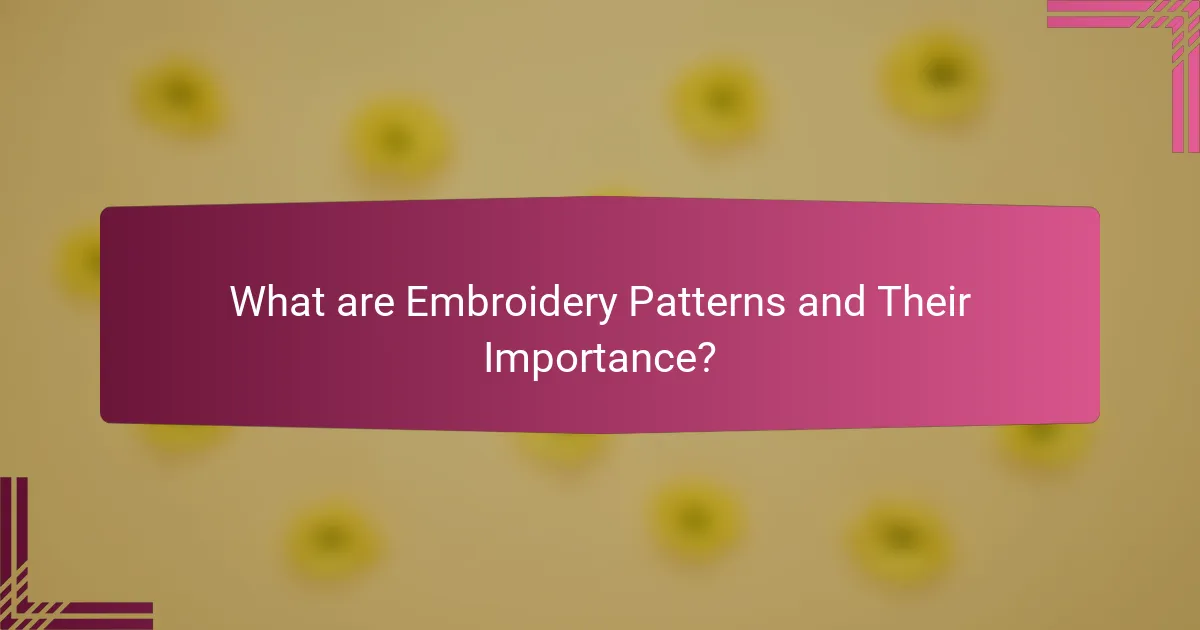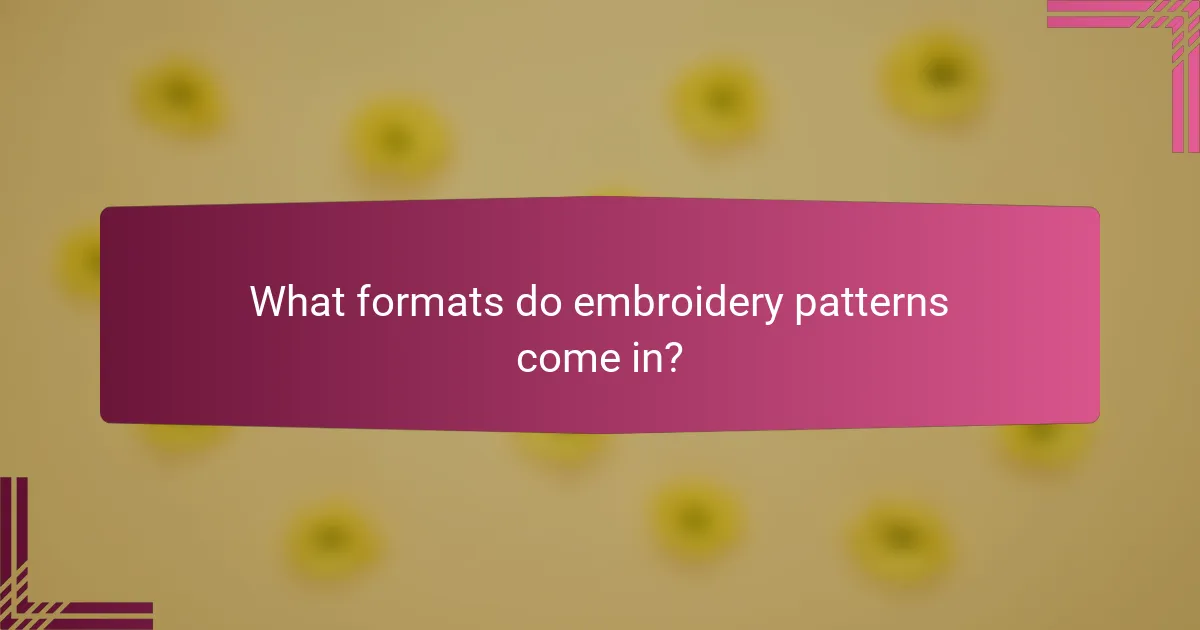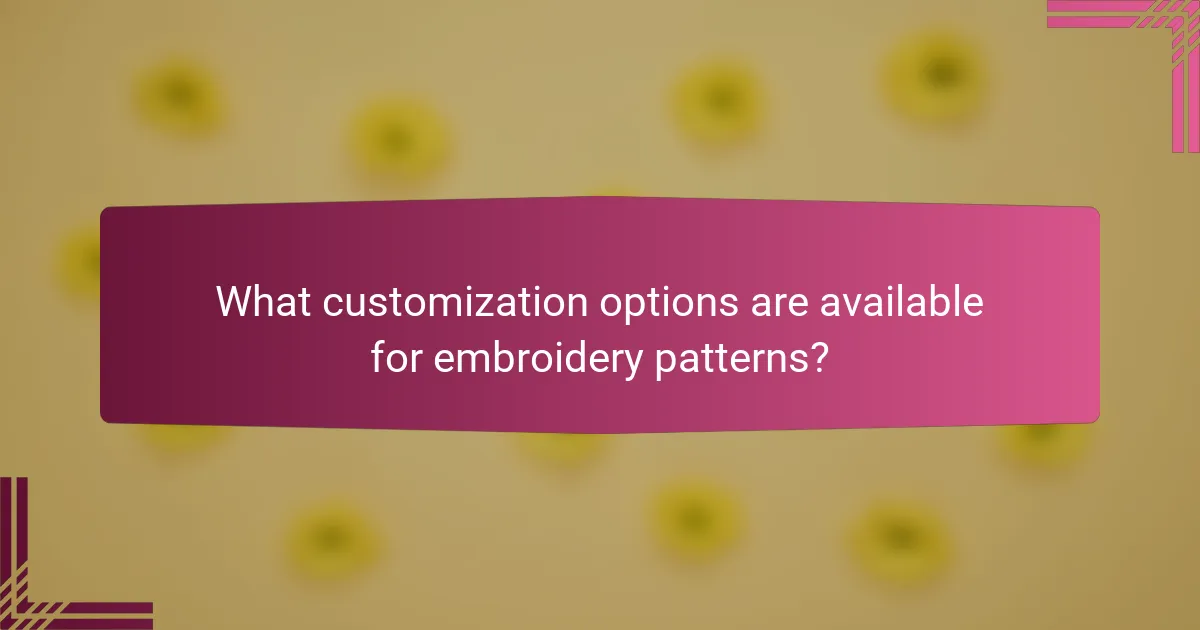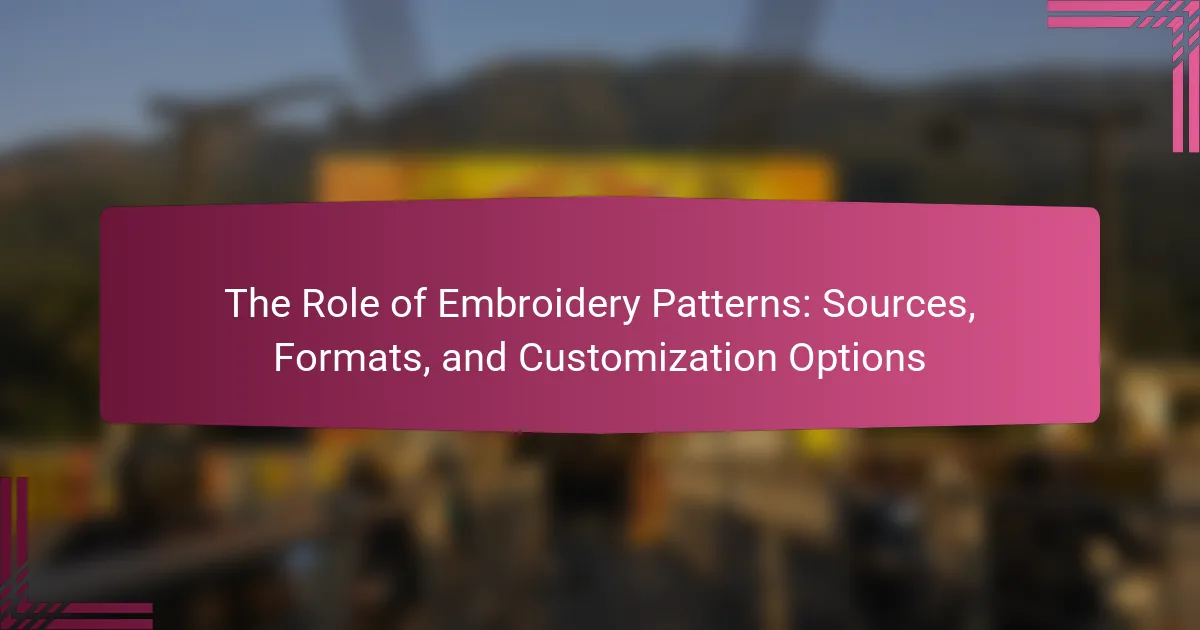
What are Embroidery Patterns and Their Importance?
Embroidery patterns are designs used as templates for stitching on fabric. They guide the placement and type of stitches in embroidery projects. Patterns can vary in complexity, from simple shapes to intricate designs. Their importance lies in providing structure and creativity to embroidery work. Patterns ensure uniformity and precision in the finished product. They also serve as a source of inspiration for crafters. Many patterns are available in digital formats for easy access and customization. The use of embroidery patterns can enhance the aesthetic appeal of garments and home decor.
How do embroidery patterns enhance textile design?
Embroidery patterns enhance textile design by adding intricate visual details and texture. These patterns can transform plain fabrics into unique pieces. They provide a means of personalization, allowing for customization in fashion and home décor. Historical usage of embroidery in different cultures demonstrates its significance in textile art. For instance, traditional embroidery techniques from various regions often reflect cultural identities. Additionally, the use of color and design in embroidery can evoke specific emotions and themes. Studies show that textiles with embroidery often have higher perceived value. This enhances marketability and consumer interest in embroidered textile products.
What role do colors and motifs play in embroidery patterns?
Colors and motifs are essential elements in embroidery patterns. They significantly influence the aesthetic appeal and symbolism of the designs. Colors can evoke emotions and convey meanings, while motifs often represent cultural or thematic significance. For example, red may symbolize luck in some cultures, while floral motifs can signify beauty and nature. The combination of specific colors and motifs can also create a visual narrative within the embroidery. Historical context shows that different regions have unique color palettes and motifs, reflecting their traditions. This interplay enhances the overall impact of the embroidery, making it more than just a decorative piece.
How do embroidery patterns contribute to cultural expression?
Embroidery patterns contribute to cultural expression by reflecting the history, beliefs, and values of a community. Each pattern often carries symbolic meanings specific to a culture. For instance, traditional motifs can represent local flora, fauna, or significant historical events. These designs are passed down through generations, preserving cultural identity. Additionally, embroidery serves as a medium for storytelling, showcasing personal and communal narratives. Studies show that specific patterns can be linked to regional styles, highlighting diversity within cultures. Overall, embroidery patterns serve as visual languages that communicate cultural heritage and identity.
What are the different types of embroidery patterns?
Embroidery patterns can be categorized into several distinct types. Common types include cross-stitch, satin stitch, and appliqué. Cross-stitch features X-shaped stitches forming a grid pattern. Satin stitch creates a smooth, shiny finish with closely spaced stitches. Appliqué involves sewing a piece of fabric onto another, creating a layered effect. Other types include embroidery on canvas, machine embroidery, and hand embroidery. Each type serves different artistic and functional purposes in textile design.
What distinguishes traditional embroidery patterns from modern ones?
Traditional embroidery patterns are characterized by their historical techniques and cultural significance. These patterns often feature intricate designs that reflect specific cultural narratives or regional styles. They typically utilize hand-stitching methods, which emphasize craftsmanship and heritage. In contrast, modern embroidery patterns incorporate contemporary designs and technology. They may use machine embroidery techniques, allowing for mass production and diverse styles. Modern patterns often prioritize functionality and aesthetic appeal over cultural storytelling. This shift reflects broader trends in fashion and art, where innovation meets tradition.
How do geometric and floral patterns differ in usage?
Geometric patterns are often used for their structured and symmetrical designs. They provide a modern and minimalist aesthetic, making them popular in contemporary fashion and interior design. Floral patterns, on the other hand, are characterized by their organic and flowing shapes. They evoke a sense of nature and femininity, commonly found in traditional textiles and vintage styles. Geometric patterns are frequently utilized in branding and graphic design due to their clarity and boldness. In contrast, floral patterns are typically used in products aimed at conveying warmth and comfort, such as home decor and clothing. The distinct characteristics of each pattern type influence their application in various design contexts.

Where can you find sources for embroidery patterns?
You can find sources for embroidery patterns in various locations. Online platforms such as Etsy and Pinterest offer a wide range of patterns. Websites dedicated to crafting, like Craftsy and Embroidery Library, also provide numerous options. Additionally, many sewing and craft stores sell physical books or magazines containing patterns. Local community groups or classes may share patterns as well. These sources ensure a diverse selection catering to different skill levels and styles.
What are the best online resources for embroidery patterns?
The best online resources for embroidery patterns include websites like Etsy, Urban Threads, and Embroidery Library. Etsy offers a vast marketplace with unique patterns from independent designers. Urban Threads specializes in modern and edgy designs, catering to various styles. Embroidery Library provides a large selection of high-quality patterns, often categorized for easy navigation. Other notable resources include Creative Fabrica and Sew Aqua, which offer both free and paid patterns. Each of these platforms features user reviews and ratings to help crafters choose the best options.
How do social media platforms contribute to pattern sourcing?
Social media platforms contribute to pattern sourcing by facilitating the sharing and discovery of embroidery designs. Users can post images of their creations, which inspires others in the community. Platforms like Instagram and Pinterest serve as visual search engines for pattern ideas. Hashtags related to embroidery help categorize and index designs for easy access. Additionally, social media groups allow for discussions about techniques and sources. This interaction fosters collaboration among crafters, leading to innovative patterns. According to a survey by Craft Industry Alliance, 70% of crafters use social media for inspiration. Thus, social media is a vital tool for sourcing and sharing embroidery patterns.
What role do embroidery magazines and books play in pattern discovery?
Embroidery magazines and books serve as vital resources for pattern discovery. They provide a curated selection of designs that cater to various skill levels. These publications often feature step-by-step guides, making patterns accessible to beginners. Additionally, they showcase trends and innovations in embroidery, inspiring creativity. Many magazines include interviews with designers, offering insights into their techniques. Books often compile extensive collections of patterns in one place for easy reference. This accessibility helps stitchers explore diverse styles and techniques. Overall, embroidery magazines and books significantly enhance pattern discovery for enthusiasts.
What are the benefits of using commercially available patterns?
Commercially available patterns provide convenience and accessibility for crafters. They save time by eliminating the need for design creation. These patterns often come with clear instructions, making them user-friendly. Many commercially available patterns are tested for accuracy, ensuring reliable results. They offer a wide variety of designs, catering to diverse tastes and skill levels. Additionally, purchasing patterns supports designers and the crafting community. This practice helps maintain a market for innovative and high-quality designs. Overall, using commercially available patterns enhances the crafting experience through ease and variety.
How do pre-made patterns save time for crafters?
Pre-made patterns save time for crafters by providing ready-to-use designs. These patterns eliminate the need for crafters to create their own designs from scratch. Crafters can immediately start their projects without the planning phase. This efficiency allows for quicker project completion. Pre-made patterns often include detailed instructions, reducing the time spent on figuring out techniques. They are also available in various formats, making them accessible for different crafting methods. Using pre-made patterns can significantly shorten the time from concept to finished product. This time-saving aspect is especially beneficial for those with tight schedules or multiple projects.
What are the cost considerations when purchasing patterns?
Cost considerations when purchasing patterns include the price of the pattern itself, which varies based on complexity and design. Additional costs may arise from licensing fees for commercial use. The format of the pattern, whether digital or physical, can also influence the price. Customization options typically incur extra charges. Shipping costs apply for physical patterns, affecting total expenditure. Bulk purchases may offer discounts, lowering the average cost per pattern. Finally, evaluating the quality and reputation of the source can impact long-term value.

What formats do embroidery patterns come in?
Embroidery patterns come in various formats, including DST, PES, JEF, and EXP. DST is a common format used by many embroidery machines. PES is compatible with Brother and Baby Lock machines. JEF is designed for Janome machines, while EXP is used for Melco embroidery systems. Each format has unique characteristics suited for specific machines. Compatibility with machine software is crucial for effective usage. These formats allow for diverse design options in embroidery projects.
What are the common digital formats for embroidery patterns?
Common digital formats for embroidery patterns include DST, PES, JEF, EXP, and ART. These formats are widely used in the embroidery industry. DST is a format developed by Tajima and is popular for its compatibility with many machines. PES is associated with Brother machines and supports color information. JEF is used by Janome machines and offers ease of use. EXP is often utilized for multi-needle machines and supports larger designs. ART is a proprietary format for Wilcom software, allowing for advanced editing features. Each format has unique attributes that cater to specific machine requirements and user preferences.
How do file formats like PES and DST differ in usage?
PES and DST are both embroidery file formats, but they differ in usage. PES files are primarily used with Brother and Baby Lock embroidery machines. They support a wide range of thread colors and detailed designs. DST files, on the other hand, are widely used by Tajima embroidery machines. They focus on stitch data and are often more limited in color representation. PES files can store more complex designs, while DST files are simpler and more efficient for industrial use. This distinction affects how embroiderers choose files based on their machine compatibility and the complexity of their projects.
What are the advantages of using vector formats for embroidery?
Vector formats provide precise scalability for embroidery designs. They maintain quality at any size without pixelation. This ensures that intricate details remain sharp and clear. Vector files are also smaller in size compared to raster images. This results in faster loading times and easier storage. Additionally, vector formats allow for easy editing and customization. Designers can modify colors and shapes without losing quality. These advantages make vector formats ideal for professional embroidery applications.
How do physical patterns differ from digital patterns?
Physical patterns are tangible designs created using materials like thread and fabric. They can be physically touched and manipulated. Digital patterns are virtual designs created using software. They exist in a digital format and can be easily modified.
The creation of physical patterns often involves techniques such as stitching, weaving, or printing. In contrast, digital patterns are generated through graphic design software. This allows for precise adjustments and easy replication.
Physical patterns may require more time and resources to produce. Digital patterns can be shared instantly across platforms. Additionally, physical patterns have limitations based on material properties. Digital patterns can utilize unlimited colors and complex designs without physical constraints.
The permanence of physical patterns is influenced by wear and tear over time. Digital patterns can be stored indefinitely without degradation. Thus, the primary difference lies in their material existence and methods of creation.
What are the pros and cons of using paper patterns?
Using paper patterns has distinct pros and cons.
Pros include ease of use. Paper patterns are readily available and often come with clear instructions. They allow for precise cutting, ensuring accurate measurements. Additionally, paper patterns can be reused multiple times, making them cost-effective.
Cons involve the potential for wear and tear. Paper patterns can tear or become damaged with repeated use. They may also be less flexible than digital patterns, limiting customization options. Furthermore, storing paper patterns can be cumbersome, requiring space and organization.
Overall, paper patterns offer a blend of accessibility and limitations in the embroidery process.
How can digital patterns be customized more easily?
Digital patterns can be customized more easily through user-friendly design software. These tools often include drag-and-drop functionality. They provide pre-made templates for quick modifications. Advanced software allows for precise adjustments in color, size, and shape. Many platforms offer tutorials to help users navigate features. Additionally, online communities provide support and inspiration for customization. Cloud storage enables easy access and sharing of designs. These advancements streamline the customization process significantly.

What customization options are available for embroidery patterns?
Customization options for embroidery patterns include color selection, size adjustments, and design alterations. Users can choose specific thread colors to match their preferences or branding. Size adjustments allow patterns to be scaled up or down for different projects. Design alterations can include adding text, changing motifs, or combining multiple designs. Additionally, users may opt for custom shapes or layouts to suit unique needs. Many embroidery software programs support these customization features, enabling users to create personalized patterns easily. This flexibility enhances the creative possibilities for individual projects.
How can you personalize embroidery patterns for unique projects?
You can personalize embroidery patterns by modifying design elements, colors, and sizes. First, choose a base pattern that resonates with your project theme. Next, alter the colors to match the desired aesthetic or brand identity. You can also adjust the size of the pattern to fit the specific item you are embroidering. Incorporating initials or specific motifs adds a unique touch to the design. Additionally, using software allows for more intricate changes and customizations. This approach enhances the overall uniqueness of the project. Personalization can lead to more meaningful and memorable creations.
What techniques are used to modify existing patterns?
Techniques used to modify existing embroidery patterns include digitization, resizing, color adjustment, and adding or removing elements. Digitization involves converting hand-drawn designs into digital formats. Resizing allows patterns to be scaled up or down without losing quality. Color adjustment enables the alteration of thread colors to match specific preferences. Adding or removing elements can customize designs to fit particular themes or styles. These techniques enhance the versatility and personalization of embroidery patterns.
How does color selection impact the customization process?
Color selection significantly impacts the customization process by influencing the overall aesthetic and emotional response of the final product. The chosen colors can enhance brand identity and convey specific messages or feelings. For example, warm colors can evoke excitement, while cool colors often promote calmness. Additionally, color combinations can affect visibility and readability, especially in embroidered designs. According to a study by the Institute for Color Research, color increases brand recognition by up to 80%. This highlights the importance of thoughtful color selection in achieving desired outcomes in customization.
What tools and software can assist in pattern customization?
Software that can assist in pattern customization includes Adobe Illustrator, CorelDRAW, and Ink/Stitch. Adobe Illustrator allows users to create and modify vector designs. CorelDRAW offers extensive tools for graphic design and editing. Ink/Stitch is a free extension for Inkscape that specializes in embroidery design. These tools provide features for adjusting colors, shapes, and sizes of patterns. They also support various file formats commonly used in embroidery. Users can export designs directly to embroidery machines. This capability streamlines the customization process significantly.
Which embroidery design software is most user-friendly?
Brother PE-Design is considered the most user-friendly embroidery design software. It features an intuitive interface that simplifies the design process. Users can easily navigate through its tools and options. The software includes helpful tutorials and guides. It supports various file formats for compatibility. Additionally, it offers a variety of built-in designs and fonts. User reviews consistently highlight its ease of use. This combination makes it ideal for beginners and experienced users alike.
How can online pattern editors enhance customization capabilities?
Online pattern editors enhance customization capabilities by providing users with intuitive tools to modify designs. These tools allow for adjustments in color, size, and pattern placement. Users can upload their own images and integrate them into existing patterns. Many editors offer pre-set templates that can be tailored to individual preferences. This flexibility supports unique, personalized creations for embroidery projects. Studies show that user-friendly interfaces increase engagement and satisfaction in design processes. Enhanced customization leads to greater creativity and expression in embroidery.
What best practices should you follow when customizing embroidery patterns?
When customizing embroidery patterns, ensure to choose appropriate software for design. Use vector-based programs for scalability and precision. Select high-resolution images to maintain clarity during the embroidery process. Consider the fabric type to determine suitable stitch types and densities. Test the design on a similar fabric before finalizing. Adjust thread colors to match the desired outcome accurately. Keep the design simple to avoid complications during stitching. Regularly save your work to prevent data loss.
Embroidery patterns are designs used as templates for stitching on fabric, playing a crucial role in ensuring uniformity and creativity in embroidery projects. This article explores the importance of embroidery patterns, their impact on textile design, and the cultural expressions they represent. It also categorizes different types of patterns, distinguishes traditional from modern designs, and discusses the significance of colors and motifs. Additionally, the article provides insights into sourcing, customizing, and utilizing various formats of embroidery patterns, including digital and physical options, while highlighting best practices for effective customization.
